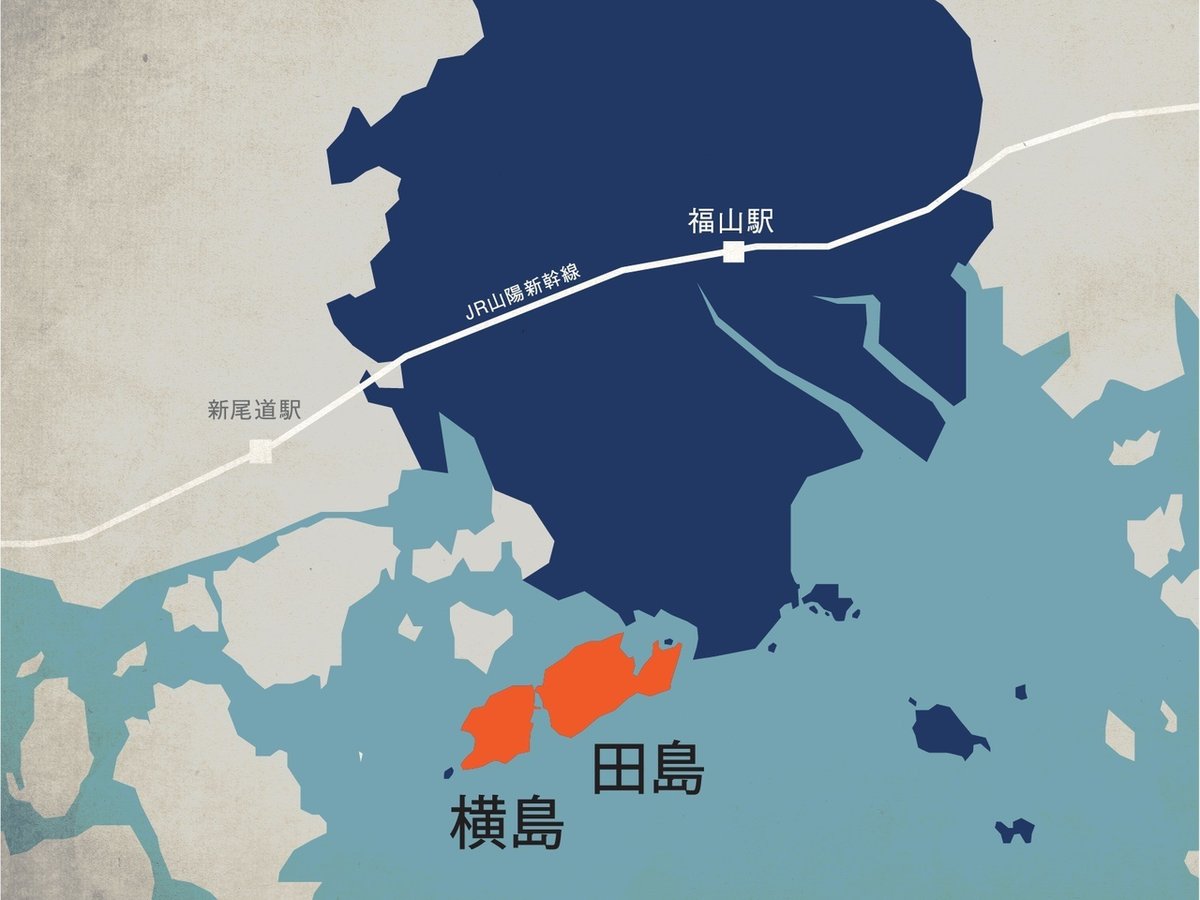
福山から渡る島【1泊trip 内海町】 trip from Fukuyama
地図を眺めると、福山から橋が架かる少し大きな島に「田島」がある。その島の先からさらに橋が架かって「横島」がある。福山から少し足を伸ばして、この2つの島へショートトリップに出ることにした。

本土と島を繋ぐ内海大橋が架かったのは、1989年。2003年には、「田島」と「横島」が合併して、内海町が生まれた。主な産業は漁業。なかでも海苔は広島県最大の生産量を誇る。
美味しいものがあると聞くだけで、まだ見ぬ土地まで行ってみたくなる。

福山駅を出発して、バスで50分。くの字型に曲がる内海大橋を渡って内海町に到着した。
まずはお昼を食べようと見つけたのが、食堂「船長さん」。店主は船長だったのだろうか。と思って扉を開けたが、切り盛りしているのは地元のお母さんたちだった。

おかずはガラスケースの中から選ぶ。酢漬けや煮物になった魚に並んで、こんがり焼かれた新サンマを見つけた。

店内では、まだ昼間だというのに常連さんたちがビールを傾ける。早朝からのひと仕事を終えた後なのか、上機嫌に「おかわり!」と言って、お母さんたちに「ほどほどにしなさい」と呆れられている様子が可笑しい。

このあたりの漁は、沿岸を回遊する魚の通り道に網を仕掛ける「定置網」と、海底に袋状の網を降ろして曳くことで海底付近にいる魚を捕る「底引き網」とで行われているらしい。一体どんな魚が捕れるのだろう。

「カネト水産」で生簀の中を覗くと、いろんな大きさのエビ、イカ、タコ、スーパーでは見たことがない魚も泳いでいる。ここには瀬戸内海じゅうの漁師たちがその日の収穫を届けるのだという。「買うかい?」とおじさんに聞かれたが、旅の途中なので諦める。

さらに集落を散策していると「絵とお茶 テレレ」という不思議な名前の店を見つけた。

古民家を改装した画廊喫茶。海の絵がたくさん飾ってある。「それ、全部僕が描いたの」。振り返ると、にこにこ顔のおじさんが立っていた。店主で画家の小川憲一さんは、海を描きたくて京都から内海町へ移り住んで来たのだそう。

「ちょっとおいで」と言われてついて行くと、ベランダから広がる秘密基地のような場所に着いた。木々の隙間からは海が見える。

敷地内にはマンガ部屋もある。小川さんは、「よく子どもが遊びに来るんだよ。どうしてそんなことをしているのかって? そりゃあ、自分が楽しいからに決まっているじゃない」。制作の合間には、近所の子どものために遊具をつくることもあるそう。冒険心のある大人って、最高にかっこいい。
お店では、妻であるアルゼンチン出身のマリアイネスさんのお菓子とお茶を楽しめる。「良かったらどうぞ」とマリアイネスさんが差し出してくれたのは、アルゼンチンの伝統菓子「アルファフォーレス」。2枚のクッキーの間に煉乳を煮込んでつくったジャムが挟んであって、どっしり甘くてクセになる。

再びバスに乗って海沿いを走り向かったのは、海と山の間にある内浦地区。「せっかく漁師町に来たのだから魚の捌き方を覚えて帰りたい」。そんなことを思っていた私に地元の人が「民宿あそび」を紹介してくれた。日帰りで福山駅まで戻ることももちろんできるけど、せっかくなので島で1泊してみることにした。
築200年の民家を改修した宿は、家の中心に囲炉裏があってなんともかっこいい。今夜は、ここに泊まって漁師の奥さんから鯛の姿造りを教えてもらうのだ。

先生は、漁師の夫とともに漁船に乗っていたという岡田さん。出してきてくれたのは、天然の鯛。
「これは夕方締めたもの。活きが良すぎると味が淡白になってしまうから、締めてから少し時間をおいて使うの」
まずは鱗を取ってエラと内臓を処理する。そして3枚に下ろし、皮を剥いで丁寧に包丁を引いて刺身にしたら盛り付ける。

不器用な私も岡田さんのサポートのもとどうにかやり切った。捌いたばかりの鯛は、噛むと弾力がある。鯛のあらを使ったみそ汁と鯵の干物もいただく。
翌日、岡田さんが海沿いをドライブに連れて行ってくれた。山を下ると、海を抱くように丸く広がる小さな湾に出た。
「昔はここで夫と養殖をやっていてね。私は尾道から嫁いで来たんだけど、彼の仕事が『生産者』と聞いて、最初はてっきり農業だと思っていたの。それが来てみたら魚の養殖。びっくりしたわ。私、魚の匂いって苦手で食べられなかったから」。
しかし、内海町で捕れる新鮮な魚を食べるうちにすっかり魚好きになり、この島の豊かさを身をもって感じる日々なのだそう。

さらに岡田さんが立ち寄ってくれたのは、「マルコ水産」。もともと海苔を自家養殖していた家業を先代から引き継ぎ、お店を開き、製造をも手掛けるようになったのが窪田佳織さん。初摘みの一番海苔を買ったら、「トーストの上にチーズとのせて焼いても美味しいですよ」と教えてくれた。

「内海大橋」が架かったことで便利になった反面、島から出る人たちも増えて島の文化が薄れてしまったと話す人もいる。けれどここには、自慢の風景と文化を惜しみなくシェアしてくれる人たちがいる。
伏見町から片道1時間のショートトリップ。美味しいものとかっこいい地元の人たちに出会える島の旅だ。
【訪ねた場所】
●船長さん
広島県福山市内海町イ3079
9:00~17:00/水曜休
084-986-2479
●絵とお茶 テレレ
広島県福山市内海町ロ3018-2
11:00~17:00/土・日・月のみ営業
084-986-2770
*隣接する醤油蔵跡には原爆の絵の展示も
●民宿あそび
広島県福山市内海町イ2084
090-3177-6733(岡田さん)
●マルコ水産
広島県福山市内海町イ1427-28
9:00~17:00/不定休
084-986-2418
公式HP
【内海町へのアクセス】

① バス
福山駅前〜天満(トモテツバス 瀬戸経由「内海農協前行」行 6番乗り場)
●所要時間:約47分
●乗車料金:750円
② 車
福山駅前〜内海町
●所要時間:約32分
瀬戸内への旅の玄関口
福山駅前のまちやど「AREA INN FUSHIMICHO FUKUYAMA CASTLE SIDE」
●公式Webサイト
住所:伏見町4-33 FUJIMOTO BLDG. 1F(RECEPTION)
AREA INN FUSHIMICHOは、まち全体をひとつの「宿」と見立てた「まちやど」です。泊まる、食べる、くつろぐ、学ぶ、遊ぶ、さまざまな要素がまちのなかに散りばめられています。チェックインを済ませたら、伏見町、そして福山のまちから瀬戸内への旅へ。
この記事が気に入ったらサポートをしてみませんか?
